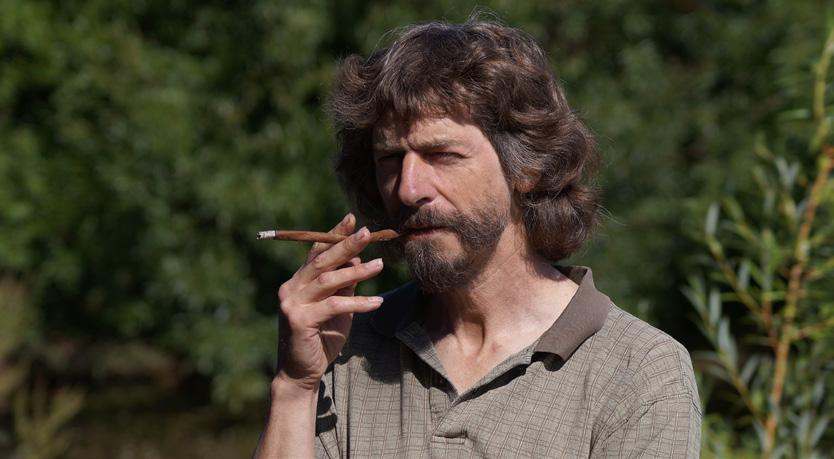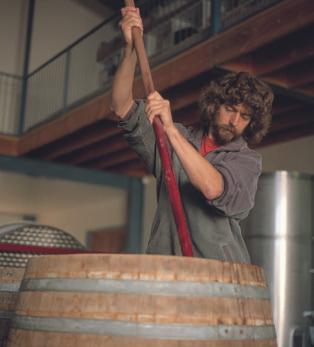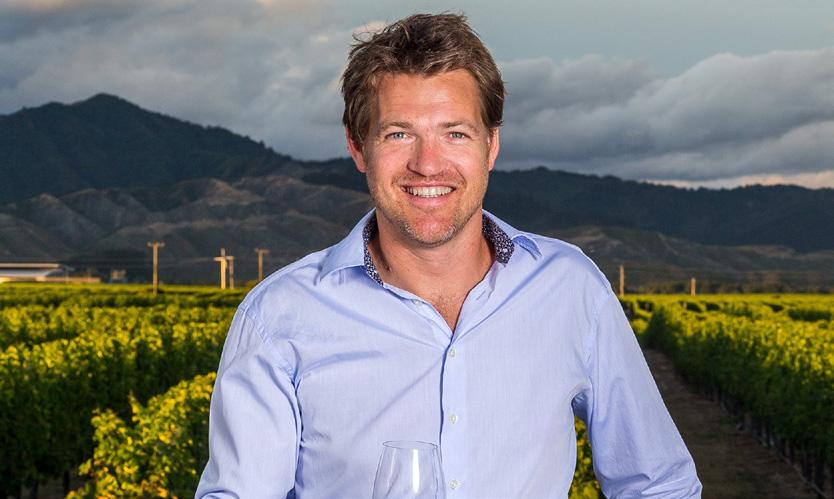
7 minute read
Pioneer - Hätsch Kalberer
Industry Pioneer
Forging a path for the love of fine wines
Advertisement
SOPHIE PREECE
HÄTSCH KALBERER was 22 when he rejected the church and Swiss military service, unable to identify with either. “I just wanted to clean up all the things I didn’t like,” says the iconic Marlborough winemaker, four decades on. Such quiet non-conformity rather defines Hätsch’s role in New Zealand’s wine industry, starting at Matawhero in 1982, when his wine passion and palate impelled founder Denis Irwin to ignore a glaring lack of formal qualification.
By 1986, Hätsch was running the cellar at Matawhero, and by the early ‘90s he had joined Georg and Ruth Fromm to plant an extraordinary vineyard of reds amid Marlborough’s burgeoning sea of Sauvignon Blanc. In the years since, he has grown Fromm’s enviable reputation for fine wines, including Pinot Noir, Malbec and Syrah, along with a Riesling Spätlese that draws hoards of Millennials at the Marlborough Wine & Food Festival.
Going against the grain is not about being arrogant, or preaching a new way, says Hätsch with gentle certainty. “You just do things you believe in.” And for him there’s simple motivation: “The whole thing I have been doing for the last 38 years comes out of appreciating fine wines.”
Hätsch grew up in the east of Switzerland, just 10 minutes’ drive from the Fromm family’s winery in Malans, although he and Georg didn’t cross paths during several vintages worked in the village. Hätsch’s love of wine was indulged when he quit compulsory military service in 1977, was subsequently taken to military court, then swiftly sacked from his office bound Government job. The courts eventually found his dismissal unlawful, but by then Hätsch was happily self-employed, spending two thirds of his time contracting back to the department that fired him, and the remaining third travelling, doing an annual vintage, and buying interesting wines.
Meanwhile, 38 years the Cold War was increasingly comes out of concerning him. “I thought, ‘I need a bit of distance from appreciating fine wines.” that’. I honestly thought that some Hätsch Kalberer madman in power would eventually push the red button.” In January 1982, he bought a one-way ticket to New Zealand (“anything further away would have been on the way home again”) with a plan to move on to work in Australia.
He set off for Hawke’s Bay to explore winery opportunities, “but of course there was no one just waiting for someone with no qualifications”. He ended up in an apple orchard instead, first as a picker and then in the packhouse, and at the end of the season found a vineyard pruning job. “I didn’t know what I was doing, but nor did anyone else there”, says Hätsch, describing New Zealand viticulture as “rather poor” at that time.
Meanwhile, he visited wineries throughout the North Island, including Matawhero in Gisborne, where his screeds of tasting notes worked as a foot in the door. Denis Irwin, who died in April this year, came to Hawke’s Bay to meet with him and Hätsch recalls the two sitting on apple boxes talking about wine, and Matawhero’s need for a European palate. “He just gave me a chance,” says Hätsch. “It was quite a learning curve, but hugely exciting to be part of the beginning of our industry as we know it today.”
Hätsch stayed at Matawhero for nine and a half years, starting as a “cellar rat” in August 1982, working his first vintage in 1983, and in charge of the winemaking
by 1986, when Denis moved to Australia. “I considered my whole time there as an extended apprenticeship in winemaking,” he says. “I grew up with wild yeasts and rather unconventional winemaking in a new world sense. And we made some really good wine.”
In those days Te Mata and Matawhero stood out above the rest of New Zealand wine, says Hätsch, who saw many trained winemakers around the country having to deal with poor fruit from over cropped vineyards to make “technically decent” wine. When Georg Fromm sought him out in the late 1980s, to discuss plans for a block of bare land in Marlborough, Hätsch saw the opportunity to learn about old world viticulture, “which ultimately would improve wine quality”. He and his partner Lavinia moved to the Wairau Plain, and in 1992 Fromm took root, with close-planted rows in a patchwork of varieties and array of clones, as Hätsch “cherry picked” new plant material when it became available.
They knew not all eight varieties would work, and some were dropped over the years, including Sangiovese and Montepulciano, which ripened in 1998, but struggled in most years. The Cabernet Sauvignon and Cabernet Franc were too herbaceous, foiled by the same characters that work so well for Marlborough Sauvignon Blanc, and while the Merlot grew well, the market did not want it from Marlborough. That left Syrah, Malbec and Pinot Noir, grown on the plains and climbing hallowed hillside vineyards like Clayvin, which Hätsch and Lavinia helped plant in 1992, together with original owners Mike and Jo Eaton.
Vavasour and Villa Maria were already making Syrah in Marlborough, although both had abandoned the variety by the time Hätsch made Fromm’s first in 1996, and “for quite a while” he was the only winemaker in Marlborough doing it. These days there are “a few committed wineries” growing Syrah, and growing it well, he adds. “They are all about transparency, finesse and elegance, with restrained concentration rather than being heavyweights.” It’s a marginal grape for the region, “but I also remember that practically all the benchmark wines of this world come from marginal climates”. It means you don’t always have a “so-called great vintage”, he says. “But you always have transparency of vintage variations and much better clarity.” Expressive wines come from climates that don’t always offer generous conditions, “and that is very exciting”, he adds. The same applies to the Malbec, which is also harvested two or three weeks later than the Pinot Noir, and makes “very exciting wines for us”.
Pinot Noir was always a more secure bet in Marlborough, but Fromm’s 1994 Reserve Pinot was a “turning point” for the region, says Hätsch. “Until that point there was no noteworthy Pinot made in Marlborough. I think a lot of people looked and thought, ‘if Fromm can, we can’.” People changed the way they grew their Pinot, with appropriate viticulture, crop levels and attention to site selection. Today he looks at hillside vineyards like Churton,

Dog Point and Clayvin (now owned by Giesen), and sees an array of Pinots, each with a unique identity. “They have character. They speak of special sites and they speak of people who want more than just a nice generic Pinot,” says Hätsch. “They want to be expressive and allow expression.” He welcomes a departure from uniform wines that might tick all the boxes and earn high marks, citing one of his favourite Burgundy producers in noting that the greatest wines are never perfect.
In the years Hätsch has been in Marlborough, he has seen it grow in mass “industrial plantings” but also with “huge positive changes on the fine wine side”. Meanwhile, the vines have aged and so has he, with both factors contributing to the subtelty , finesse and refinement of Fromm wines. “I don’t look for the obvious to impress,” he says. “That is age of vines of course and also us having a better understanding and knowing a little bit more what these vineyards can do. Beautiful wines don’t need to be loud.”
Hätsch turned 65 earlier this year, and while he’s not looking at retirement yet, he plans to lighten his load a little. “I think as long as I am of any value here, I will probably be involved for a bit longer.”
James and Annie Millton have known Hätsch “since the time he walked down Riverpoint Road in 1982 and joined Matawhero”. James describes him as “a man who is precise (Swiss to the point) that white wines (particularly Chardonnay) had to be dry and with full malo, and reds had to be warm, textured and complex”. The 1989 Matawhero Bridge Estate Cabernet Merlot is “quite probably the finest wine produced in New Zealand,” says James. “This is testament to the skill and drive which Hätsch has to make a classic wine.” Hätsch is a “genuine classic cultured gentleman”, whose knowledge of food is mouthwatering, collection of wine “profound”, and thirst for opera deep, “which shows such an intoxication for the truly fine pleasures in life”, says James. “And as a finale, there is always a cigar, but not just any cigar.”





